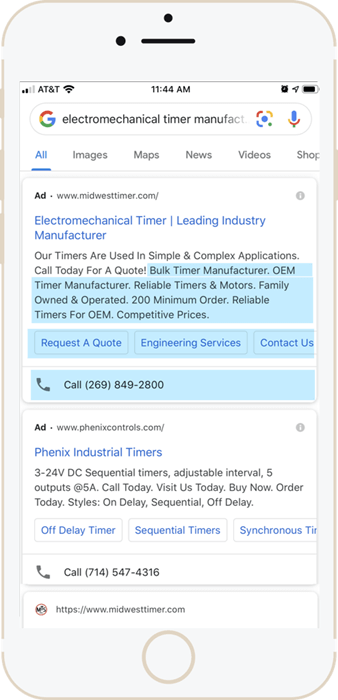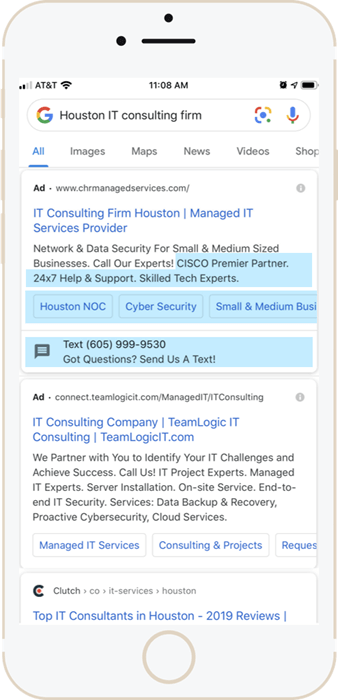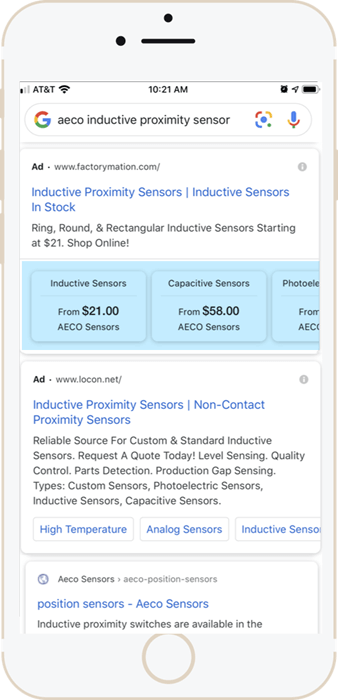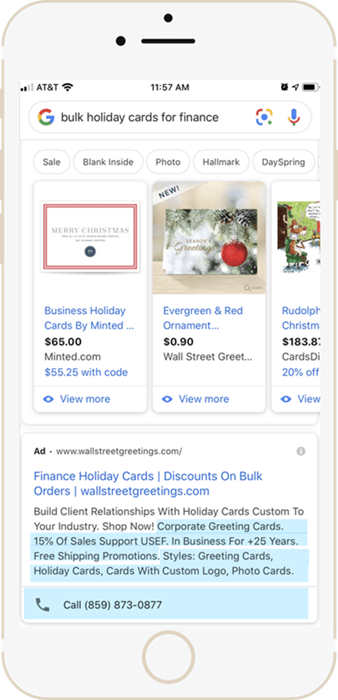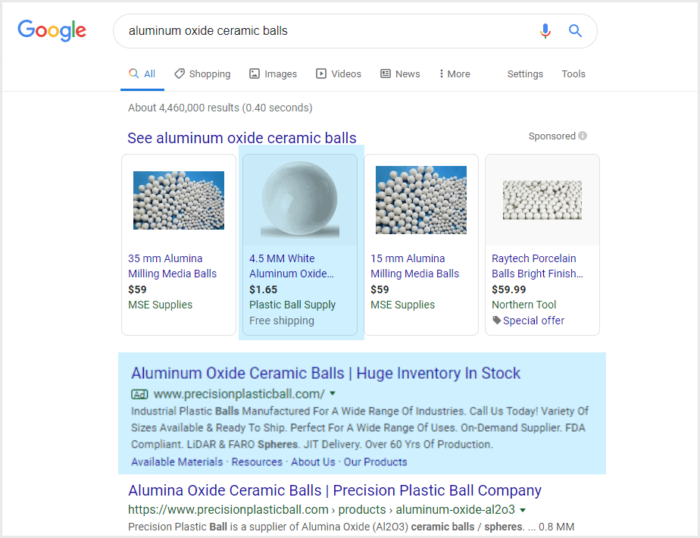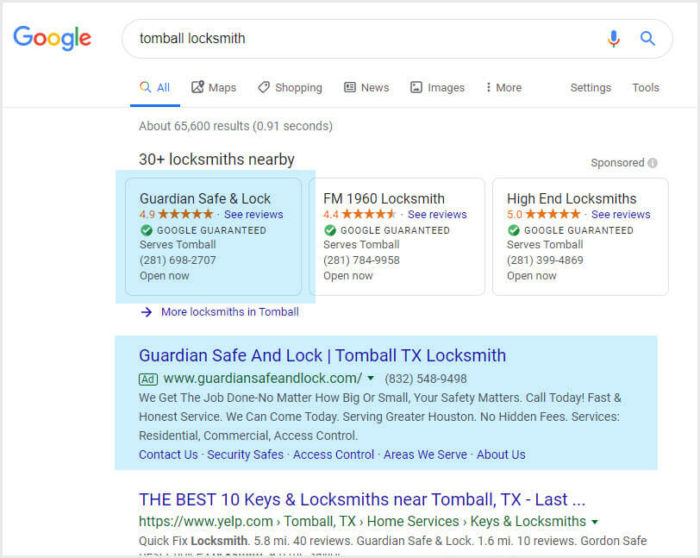November 27 2019
A Visual Guide to Understanding Google’s Ad Features
Part 2: PPC Ad Features and What They Mean for Your Business
Paid search ads, also known as PPC or Pay-Per-Click ads, are the sponsored listings often found at the top and bottom of Google, Bing, Yahoo & AOL search results. While the format of PPC Ads has evolved quite a bit over the years, these updates are typically done to meet the needs of your potential customers. However, these changes can also interfere with the amount of space allotted for your business and the other businesses competing for exposure on the first page of Google.
Google will show up to four text ads at the top of any given search results page, giving paid search ads a majority of the listings a user sees before even scrolling down. Even if you aren’t currently utilizing PPC advertising in your online strategy, understanding how these results impact your search landscape is important to factor in.
In Part 2 of our 3 Part Series, we will review the different paid search ad features being utilized within Google’s search landscape and how they can potentially impact your mobile, paid and organic marketing strategies.
Ad Extensions
When conducting a search on Google, along with the text of the paid search ads, you will find a variety of ad extensions. While ad extensions have been around in some form or fashion since 2009, they have evolved quite a bit over the years. What began as a few additional links per ad has now grown to include a variety of features. (You can view the full list of ad extension types here)
Similar to the Rich Snippets we describe in Part 1, Ad Extensions provide users with additional information about your business. Another added bonus is that Google will typically show two or three Ad Extensions per PPC Text Ad, giving each ad a large amount of real estate within the search engine results.
The gallery above showcases some of the different Ad Extensions used within Google PPC ads. You can see that the PPC ads and their featured ad extensions encompass the mobile device’s screen, with a user having to scroll down to view any additional results.
How This Affects Your Marketing Strategy
If implemented strategically on an account, campaign and ad group level, the use of relevant ad extensions within your ad text can lead to a higher click-through-rate and a more qualified end-user.
When looking at your marketing strategy from a mobile standpoint, ad extensions become even more important. Ad extensions provide more landscape for your company to be featured. And the more landscape taken up by ads, the more the organic listings are pushed down (as shown in the gallery above). With the rise of search traffic from mobile devices continuing to impact all online businesses, this is important to consider.
Shopping Ads
Google Shopping Ads are a PPC Ad type specifically for e-commerce websites that showcase a company’s products within Google’s search landscape.
Shopping Ads can appear at the top or on the right-hand side of Google’s search results and are generated from product images and detailed information imported into Google’s Merchant Center. These ads are a great way to offer visuals and more information to users searching for what you offer.
Another benefit of shopping ads is the ability to also show regular PPC Text Ads at the same time. In the examples above, TopSpot Client Precision Plastic Ball is featured twice for a targeted search query, both listings are shown above the organic search results.
How This Affects Your Marketing Strategy
With one out of every three clicks on Google paid search ads going to shopping ads (Source: WordStream) plus to the chance to showcase your website twice before a user even sees the organic listings, it’s easy to see why shopping ads are a great addition to any online strategy that can utilize them.
But what do you do when you don’t sell products through your website and shopping ads are appearing in the search landscape? It might mean that you need to reevaluate your content to see why your business is showing in this kind of landscape. What sets you apart from businesses providing stock items? Do you manufacture custom products, only sell in bulk, etc?
Local Service Ads
For businesses that offer professional services to a specific region, local service ads are excellent potential areas of growth. Users will find these results above all other local PPC ads, map listings, and organic search results. Also, similar to Google Shopping Ads, a business’s regular text ads can also be shown in conjunction with your Local Service Ads.
Similar to shopping ads, a business can be displayed twice above the organic results if utilizing regular text ads in conjunction with local service ads.
How This Affects Your Marketing Strategy
Because of their placement at the top of the page, these ads are also the first thing a mobile user sees when searching on their phones. If a map pack is showing in that landscape, your local service ad could appear there, as well. Even if there is not an immediate conversion, this placement increases your chance of converting at a later point.
The average cost per lead is around $23 so it might be worth it to your business to consider these types of ads in your overall strategy. You can also be refunded the charge if the call turns out to be spam or not a valid lead.
What Does This Mean For Your Business?
When using an integrated marketing approach, paid search data can also be used in a variety of ways to expand your organic presence. Combining organic and paid search can increase your clicks by 25%, which can result in higher profits than when using just one or the other (source: Search Engine Land).
If you have been holding back on starting a PPC or paid search campaign, it might be time to reconsider. This is especially relevant if other businesses in your space are already using paid search to grow their online presence or if your potential customers are using mobile devices (which is growing every day for every industry).


